Share Market
Lessons from the Short-Squeeze Supernova Season
It was Friday, October 11. I’d mentioned in my chat rooms there was a good chance of a Friday short-squeeze supernova. Too many shorts were trying to make back losses. And they’d all chosen Synthesis Energy Systems, Inc. (NASDAQ: SES).
By 2:30 p.m. Eastern, I was getting messages galore from those who follow this flawed strategy. Very sad. But then I had to catch a flight … so I missed what happened next.
32,000 Feet Above Europe
As I sat in my seat aboard the flight, SES was about to become the latest short-squeeze supernova. I couldn’t trade it because I was flying. But a lot of my students did…
Like Justin @justin3615:
@timothysykes dip bought $SES in the higher low @ 3.10 2.5k shares, out at 3.50 shaken by the double top and back trend, so took the profits nice lil 1k on my now 8.5k account
— Justin (@justin3615) October 11, 2020
And Jerad @Jerad11187501:
$SES what a play! I took this in the morning $3.31-$3.55 just under 10%. Even tho I sold way to early I stuck to my plan and this was a good trade. On to the next! @timothysykes @TheStockSnipers pic.twitter.com/tIBRvaJKNc
— Jerad leon (@Jerad11187501) October 11, 2020
Jared, Justin, and many other students benefited from the squeeze. It was amazing for longs. But for many newbie shorts, it was a complete disaster…
Classic Friday Short Squeeze
SES was a classic Friday short squeeze. Look at the chart from Friday. It only tells part of the story. By itself, it’s scary enough for shorts. (Great for longs…) But keep reading, because for shorts it gets worse. (Keep reading, there’s a twist…)
SES chart, October 11, 2020:
A lot of shorts were shorting into the first little run up into the $3s. (Click on the chart to open a full-size view in a new tab.) And they were doing so because it’s a fundamentally/financially flawed company.
A Lesson on Why Shorting Sucks Right Now
October 11 offered us a great lesson in why shorting sucks so bad right now. One of the seemingly best setups in a long time for shorts turned out to be the perfect trap. The stock went from the $1s to $3s on news it was acquiring Australian Future Energy.
In came the shorts. They gave all the same reasons short sellers give… “Hey, this company should be trading at zero, it’s already up from the $1s to the $3s. I’m gonna short it.”
And if you look at the chart, you can see where a lot of chat rooms attempted bear raids. This is a kind of groupthink, where everyone shorts at the same time in an attempt to drive down the price.
Every time the stock cracked a little, more shorts got excited. And with each little bounce, they piled in, shorting more shares, trying to get their average as high as possible. But what many of them failed to realize is that they were setting themselves up for disaster.
I’m not the most popular with short sellers because I rip on them nonstop. SES is an example of why they deserve it. Because there were several newbie-led chat rooms (I won’t name them) shorting in the $3–$4 range.
These chat rooms … they make fun of how many video lessons I have. They say, “You don’t need to study all that much. Sykes overcomplicates things.”
So all those shorts who averaged up on every bounce — maybe they got their average to around $3.35 thinking when it cracked to $3 they’d take 10%. But here’s the problem: what happens if it doesn’t crack?
When you risk disaster to make a little bit, you’re picking up pennies in front of a bulldozer.

RIP Newbie Shorts
So, while I was enjoying my flight, the newbie short seller’s nightmare happened. SES took roughly 45 minutes to go from the $3s to $9.
Wow $SES up to $8/share afterhiurs, congrats to soooo many https://t.co/fljCJN8USq students who made $1-4/share, remember to sell into strength and RIP to far too many newbie shorts stuck since shorting at $3-4, shorting a low float on a Friday FGD play is naivety at its finest
— Timothy Sykes (@timothysykes) October 11, 2020
This is the risk. I don’t know everything. I’m not right 100% of the time. But I do have rules in place to prevent disasters. (I trade using these rules.)
Rules Prevent Disasters
A lot of people rip on me — I have doubters and haters. But, again, the rules I teach I’ve learned over 20+ years.
And this one didn’t break just one rule. It broke four rules.
You’ll never see me short a low float, first green day runner, with news, on a Friday afternoon.
You Don’t Know What You Don’t Know
The float on SES is so small. According to Yahoo Finance, it’s 1.38 million shares. So even at $5 a share, the market cap was only $7 million. At $9 it was only roughly $12 million. Some people say, “It doesn’t deserve to be a $12 million company.”
You. Have. No. Idea.
The news released on Thursday night said they were buying another company. You don’t know how much the new company is worth. Is it worth $7 million? How about $12 million? Or is it worth $30 million?
With these nano cap stocks, $5–$20 million is nothing. So all the shorts thought it was gonna crash.
“Look, it started fading… and the volume is fading…”
When a company is trading so low in price and valuation … and when there are so many shares trading … and so many shares being shorted…
… it becomes a perfect demand versus supply vortex. There’s too much demand for the shares and not enough supply. The price has to rise.

Slaves to Their Computers and They STILL Got It Wrong
Most traders need to find an edge to get news before other traders. They’re slaves to their computers. They have 30 monitors, and they can’t miss anything. With SES, the news came out Thursday night.
So even though the news on this stock was already out, it was lost — or misjudged — by all these short sellers. This is another benefit of penny stocks. (Read this important post about how penny stocks are different.)
So the biggest move happened in the last hour or two of trading and after-hours trading on Friday. And that’s because it was all the short sellers trying to buy their way out of the mess. There wasn’t good news that tripled this company from $3 to $9.
It wasn’t like “Oh my god, something just happened and this company tripled.” It was purely a short squeeze. Too many short sellers. I’m sure there were naked short sellers.
And as my flight continued, the messages kept coming in…
Ignore My Rules and Get Crushed
I got messages from people who lost $5K … $10K … $20K … even some who’d lost $30K! Wanna know what they were all saying?
“I wish I’d never left the Tim Challenge and the Tim chat room…”
Shorting SES…
… a low float, first green day runner, with news, on a Friday…
… breaks all my rules.
Again, if you’re stubborn, feel free to break my rules. Learn the hard way.
It Sickens Me to Get These Messages
I hate getting messages from people who lose big trading stocks like $SES but you ignore my rules you get crushed so either learn from me or let the market teach you in a far more expensive/painful way, which do you choose? Either way you gotta learn as newbies risk FAR too much!
— Timothy Sykes (@timothysykes) October 11, 2020
Look, I don’t wanna mention the names of the short sellers. Because, frankly, we need them.
I’m Conflicted
I wanna show you what’s happening with this niche, where too many newbie short sellers think it’s easy. They don’t study my videos. And they don’t respect my lessons. So they keep losing. (Study my FREE penny stock guide here.)
I feel for them. But at the same time, for those of you who are long biased…
… this is an amazing time to be a trader IF you recognize how many newbie shorts there are.
There’s more…
Bad to Worse OR … SES Short Squeeze Goes Full Supernova
Over the weekend I made a video lesson about SES. I uploaded it for my students on Monday morning. (You can watch it when you join the Profit.ly community here.) I said this one could continue on Monday … to the $12s, $15s … or even the $20s.
Here’s the chart. If you’re considering a career as a short seller, get scared. Get very, very scared…
SES chart October 11 and 14:
Wisely, I didn’t get sucked into shorting SES. Too many unprepared shorts were shorting in the $3–$4 range on Friday. On Monday, the squeeze went all the way to $26+. It left many people in short-biased chat rooms not only broke but in debt to their brokers. (I use these brokers.)
Incredible short squeezes as tons of shorts trapped on $SES from the $3-4 range Friday, noe $23+, some people down 7x their investment and $BIMI I Bought at $2.55 today now it’s $9+, to anyone who still hates on penny stocks you’re dumb as fuck lol
— Timothy Sykes (@timothysykes) October 14, 2020
“But Tim, They Were Right — SES Tanked!”
It’s true. On October 15, SES crashed back to the $10s. And, yes, the fundamentals on SES are terrible. Once the newbie/early shorts got annihilated by the squeeze, the stock dropped 60% off its highs in under 24 hours.
So if you’re shorting based on fundamentals, guess what? You’re right. But does that mean all short sellers were right? Be very careful with your answer. The early shorts — all those shorting in the $3s and $4s — they were wrong.
Anyone shorting at $10 or $11 on the way up … wrong. Unless they had the stomach and a big enough account to ride it out. Even then, they’re basically at break even now.
This SES chart shows the full picture from October 11 to 17:

What about someone who managed to borrow shares and get short at $22 or even $26? People say “Oh, you can make so much money if you just get the top right and ride it down.” But you don’t know where a stock like SES is gonna top. You. Have. No. Idea.
I often call myself a glorified history teacher. It’s time for a recent history lesson…
Learn From the Past or Pay the Price
Do you remember BPTH? Back in late February/early March, Bio-Path Holdings, Inc (NASDAQ: BPTH) went from $2 to $73 in six days. Here’s the chart…

Again, BPTH was great for traders who followed the right strategies at the right time. Like SES this week, some of my students made CRAZY profits on BPTH.
CRAZY https://t.co/fljCJMRjtQ student profits today: kjc9trader Up $9870 on 3 $BPTH trades - so far! singhanz:I made $3775 today on BPTH Jimmy_Graves: Damn I made $5k on BPTH just this morning aristi0523: sold $SWRM locked in 1700 joshcrivers: all out $SWRM for 20%, $1300 profit
— Timothy Sykes (@timothysykes) March 1, 2020
Sadly, just like SES this week, the BPTH squeeze blew up early shorts.
Hearing horror stories galore on $BPTH from newbie short sellers and their followers…ignore my warnings guys and learn the hard way, it’s so stupid, but that’s what happens when you learn from non-self-made millionaires and those without decades of experience #goodtobereal
— Timothy Sykes (@timothysykes) March 7, 2020
BPTH is one example — extreme but not unique. Literally dozens of penny stocks have squeezed early shorts the last few years. WGBS, CANF, and CRK back in 2015 … REN in 2016 … IDXG in 2017 … TLRY last year … those are just a few examples off the top of my head.
And it’s getting more common. Because of people like Tim Grittani having so much success, there are WAY too many short sellers. As more newbie shorts pile into newbie-led chat rooms, they crowd each other out. The niche is so crowded it’s crazy.
Short Selling Still Works IF You Learn the Right Way
I became long biased when short selling got too crowded.
Thing is, I’m still trading the same basic patterns that made me my first million 20 years ago. I’m just playing different time periods. With all the newbie shorts piling in too soon it creates more and more short squeezes. For me, I prefer big morning panics. But that’s not to say that short selling doesn’t still work.
Kyle Williams, my latest six-figure student who I wrote about in this blog post, is short-biased. Tim Grittani, arguably the best penny stock trader in the world, is short-biased. One of my top young students, Huddie, has now made nearly $250K. Huddie is short-biased.

Let’s get back to SES for a minute. Just because newbie shorts led by other newbie shorts got crushed … it doesn’t mean all shorts got crushed. Again, it’s about knowing the patterns, following the rules, and being patient. Huddie absolutely banked on SES…
This is from the Trading Challenge chat room on October 15:
09:54 AM Huddie: Locked in 4 grand on Ses
See Huddie’s Profit.ly page here.
So even though I rip on newbie shorts all the time … and even though I say shorting sucks right now…
… the problem is shorting early and risking too much.
Huddie is successful because he put in the time. Even though shorting is overcrowded he’s profitable because he learned the rules. And he does NOT have the idiotic newbie mentality of “Short anything that’s up … sell, sell, sell!”
I love Huddie’s pinned tweet…
Put the 10,000 hours in and get here! Not a sprint, it’s a marathon. Long term goals are key!!! I was not profitable for 2 1/2 years. It takes a massive amount of focus, maturity, and responsibility. This is not some “get rich fast” scheme. This is hard work and dedication. https://t.co/7p2HJDKlSq
— H𝙪𝙙𝙙𝙞𝙚 (@MikeHuddie) July 17, 2020
That’s keepin’ it real.
Knowing the End of the Story
Trading penny stocks is like knowing the end of the story and working backward. If you know they’re gonna eventually fail, it’s a matter of looking at predictable patterns. I’ve always said you can profit on the way up … and the way down. But you gotta know the patterns. You MUST study history and be prepared.
Full-On Supernova Season
This entire blog post has been focused on SES. But SES isn’t the only game in town this week. We’re in a full-on supernova season. It’s crazy. This is a GREAT time to be a trader IF YOU ARE PREPARED.

How Penny Stock Supernovas Are Like Crocodiles
Have you ever seen crocodiles being fed? It’s pretty crazy. When one crocodile snaps its jaws shut, several more ferocious jaws go … SNAP … SNAP, SNAP, SNAP!
Penny stock supernovas happen a lot like that. And with the increasing number of short squeezes, you can almost predict it. Some of the most fundamentally flawed companies become the single hottest stocks in the market. Briefly. And before you have time to catch your breath, there’s another.
Which is why we haven’t seen just one supernova in the last week. We’ve seen six!
Like Huddie said in chat on October 14:
12:27PM Huddie: Always remember, when you get 1 great runner, usually more follow. $SES was Friday. $YUMA, $BIMI followed suit. Sympathy plays!
First, it was SES. Then it was BIMI, WWR, DTSS, BNGO, and VIVE.
Study the charts below. I really want you to get this because once you see the patterns, then you can start working on all the other things you have to know. (It’s more than just memorizing patterns. Otherwise, people who shorted SES at $3 wouldn’t still be crying. And they’re ALL still crying.)
For each of the stocks below, I’ve included a 10-day chart/one-minute candlestick and a three-month chart/daily candlestick. It’s too much for this blog post to go into detail about every stock. But it’s important you see what’s possible.
NF Energy Saving Corporation (NASDAQ: BIMI)
BIMI ran from roughly $1.50 to $13 in a little over 24 hours starting on October 14.
First the 10-day chart:
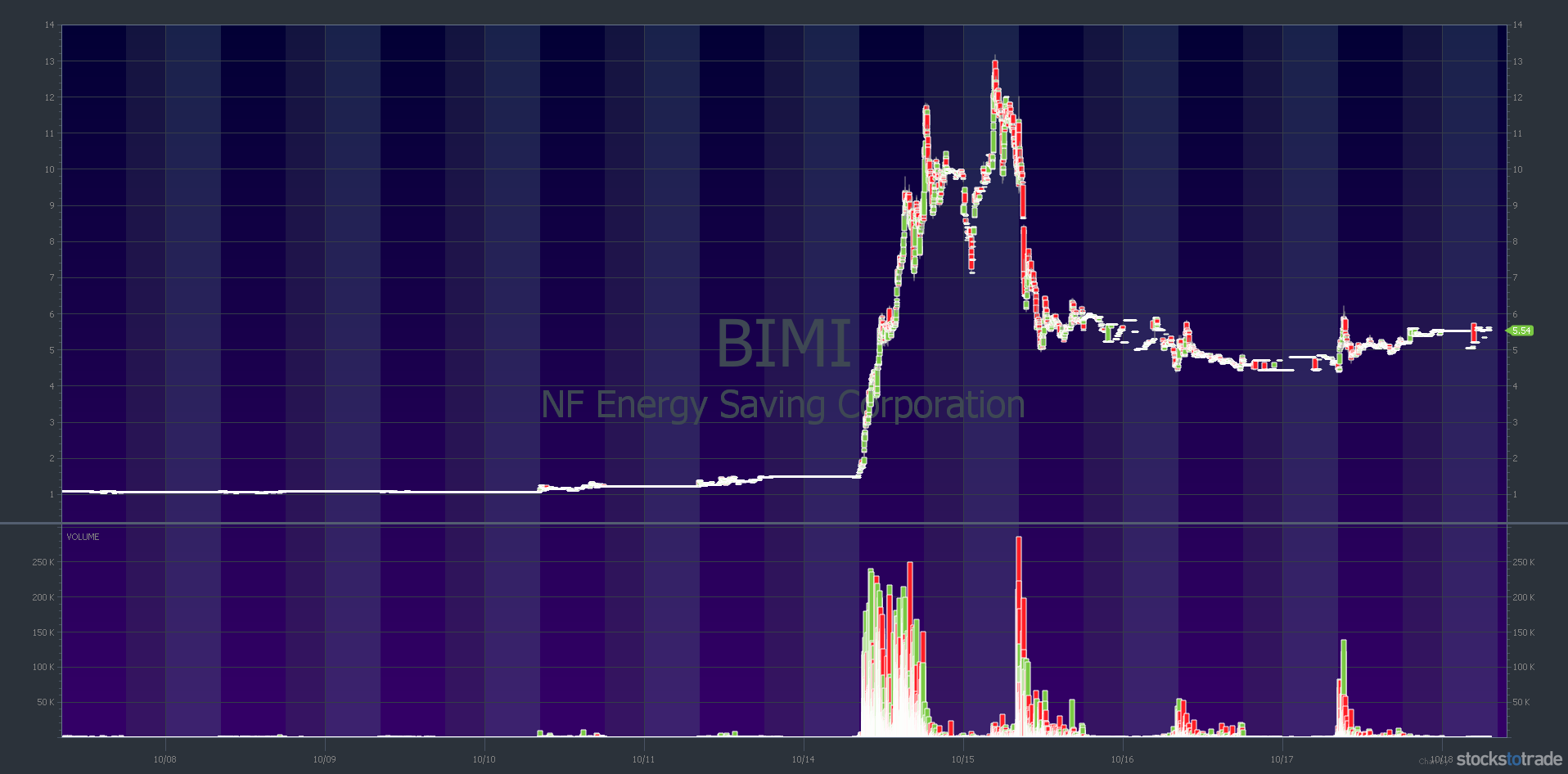
As you can see, many students made solid profits on the front side of BIMI…
Challenge Chat October 14 BIMI:
10:32AM GOO: in $BIMI 600 shares @$3.00 out $3.30 safe profits blew past my sell order lol.
10:34AM RBI: alright, out now $SES from 8.60 to 11.60. $450 before breakfast, not bad.
10:46AM Jackaroo: $BIMI took 500 from low 3s to high 4s for +$400.
10:49AM Popcheez: $BIMI in @ 3 out at 4.20 !!! so glad I got annoyed with $SES thanks Tim!!
10:50AM FrostyFro: I took my $480 profit on $BIMI - but my lord - could have been 2k+++.
11:25AM Marioa145: bought the dip on $BIMI at 3.65 out at 3.99. one second later 4.60 haha.
11:28AM keeyongtn → timothysykes: Best trade of the day $1500 $BIMI.
11:52AM the_tipsy_nomad: All out of $BIMI 1500 shares in @4.1 and out @5.6. Taking my $2250 and running for the hills.
11:57AM the_tipsy_nomad: As Tim keeps preaching, newbie shorts are great for us buyers who anticipate these short squeezes. Just like $SES did on Friday. The market is very unforgiving.
And the three-month chart:
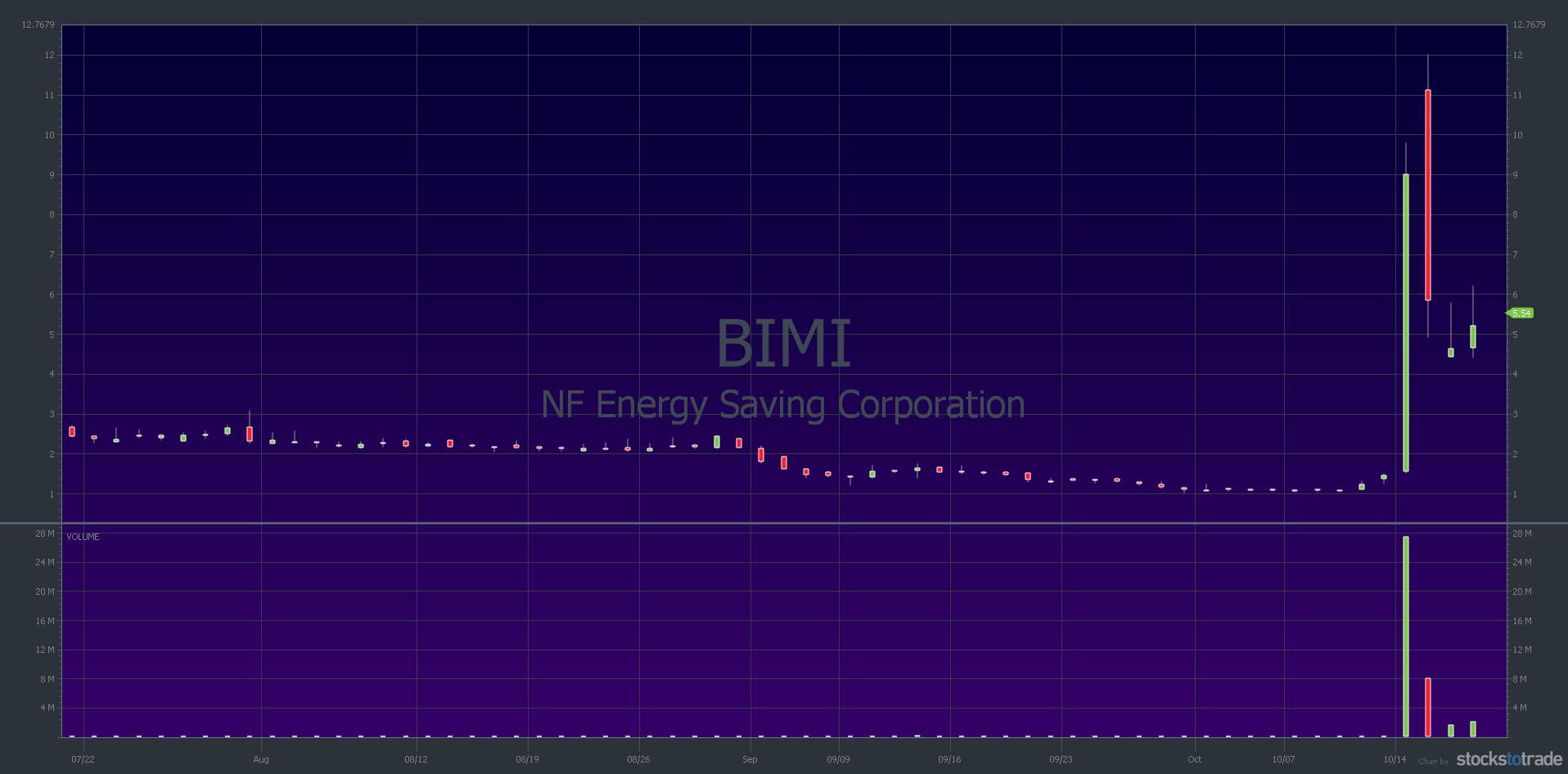
Then there was WWR…
Westwater Resources, Inc. (NASDAQ: WWR)
WWR spiked from roughly $3 to $9.25 in a few hours on October 15.
Here’s the 10-day chart:
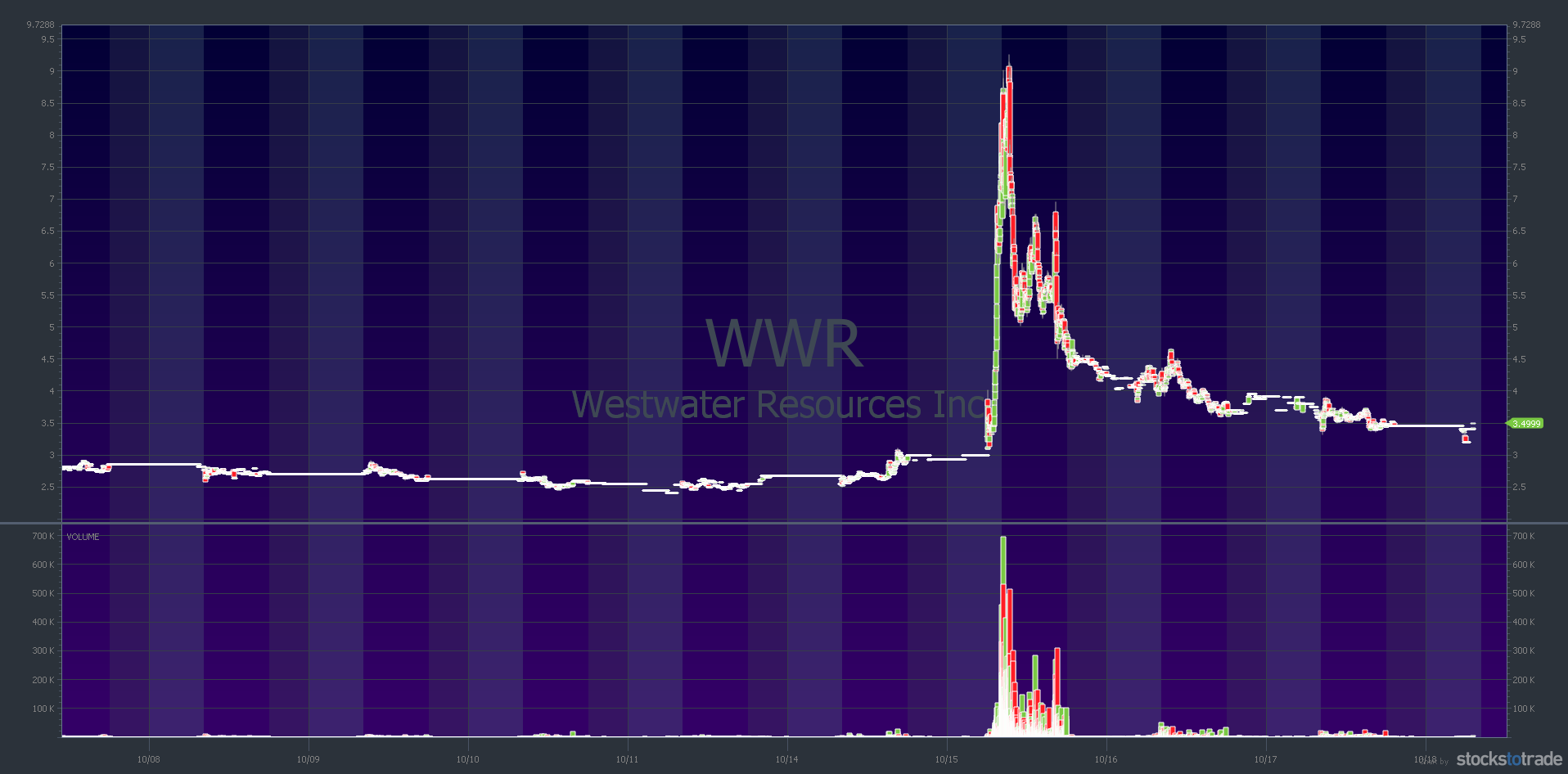
Check out some of my students’ WWR trades…
Challenge Chat October 15 WWR:
9:49AM MoonShot: $WWR in 7.28 out 7.61 500sh.
10:02AM HunterrBradley: sold $WWR from 7.14 to 8.12, feels good.
10:04AM therealmcdougal: $WWR paper trade - dip bought - long 2k shares at 7.27 average, sold at 8.27 average, got in and out quickly and made 13%.
10:04AM SatelliteIncomeUnlimited: just made 849.00 $WWR I got spooked and figured I could get back in, it’s going up and down.
10:17AM Popcheez: Bought $WWR @ 7 out at 8.3.
And the three-month chart:
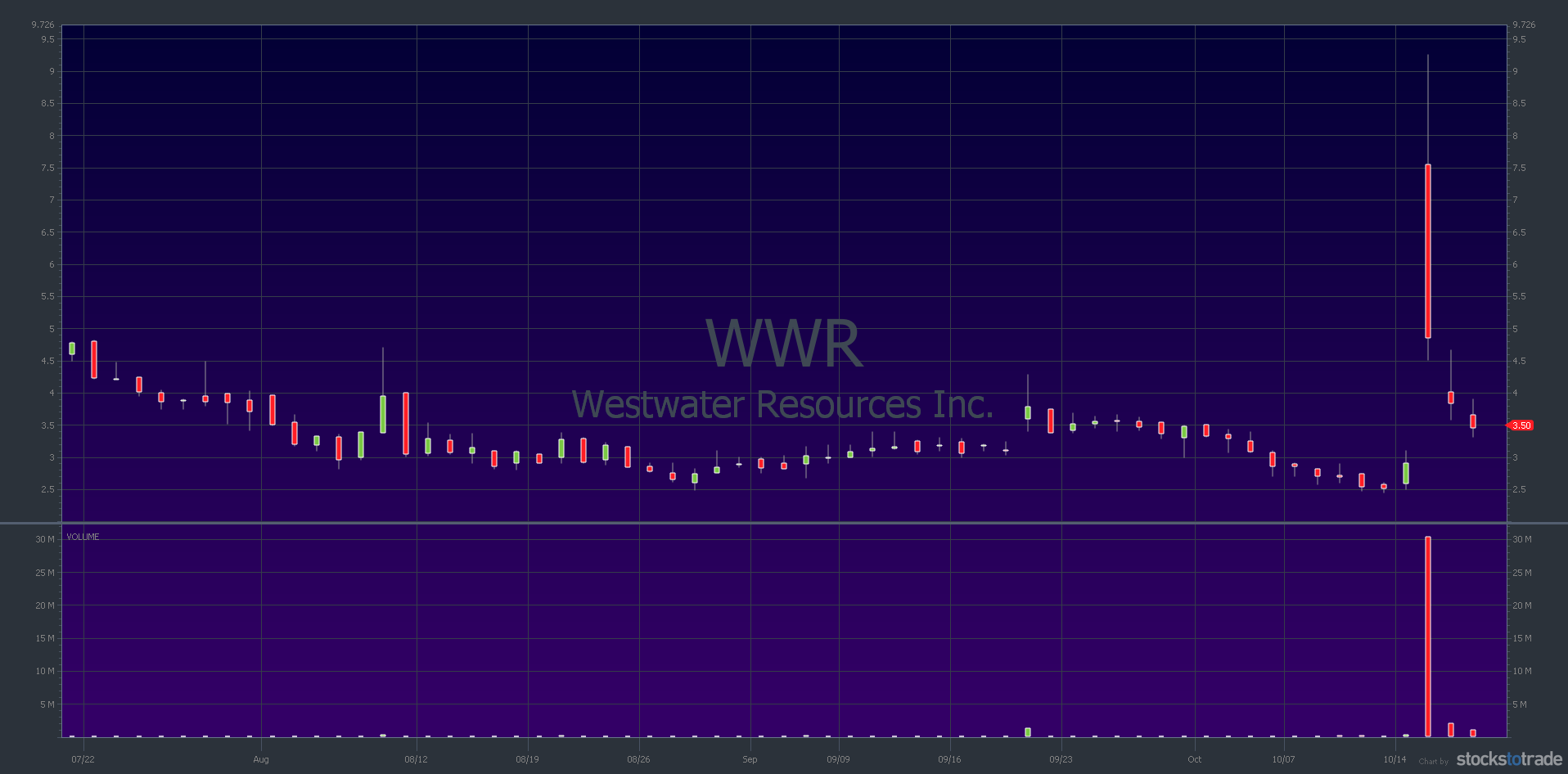
Datasea Inc. (NASDAQ: DTSS)
DTSS ran from 90 cents to $7.39 on October 15.
Check out the DTSS 10-day chart:

TimAlerts Chat October 15 DTSS:
10/15 12:15PM LUNCHB0X: out of $DTSS 4.70 from 4.07 entry.
10/15 12:17PM sgriever3: bought $dtss 4.39 sold 5.00 small position.
10/15 12:17PM gobeavs2015: $DTSS in @ 4.05 out @5. looks like sold too soon but I’ll gladly take my 20% and run.
10/15 4:44PM Knesevitch: 631+ DTSS middayperk
And the three-month chart:
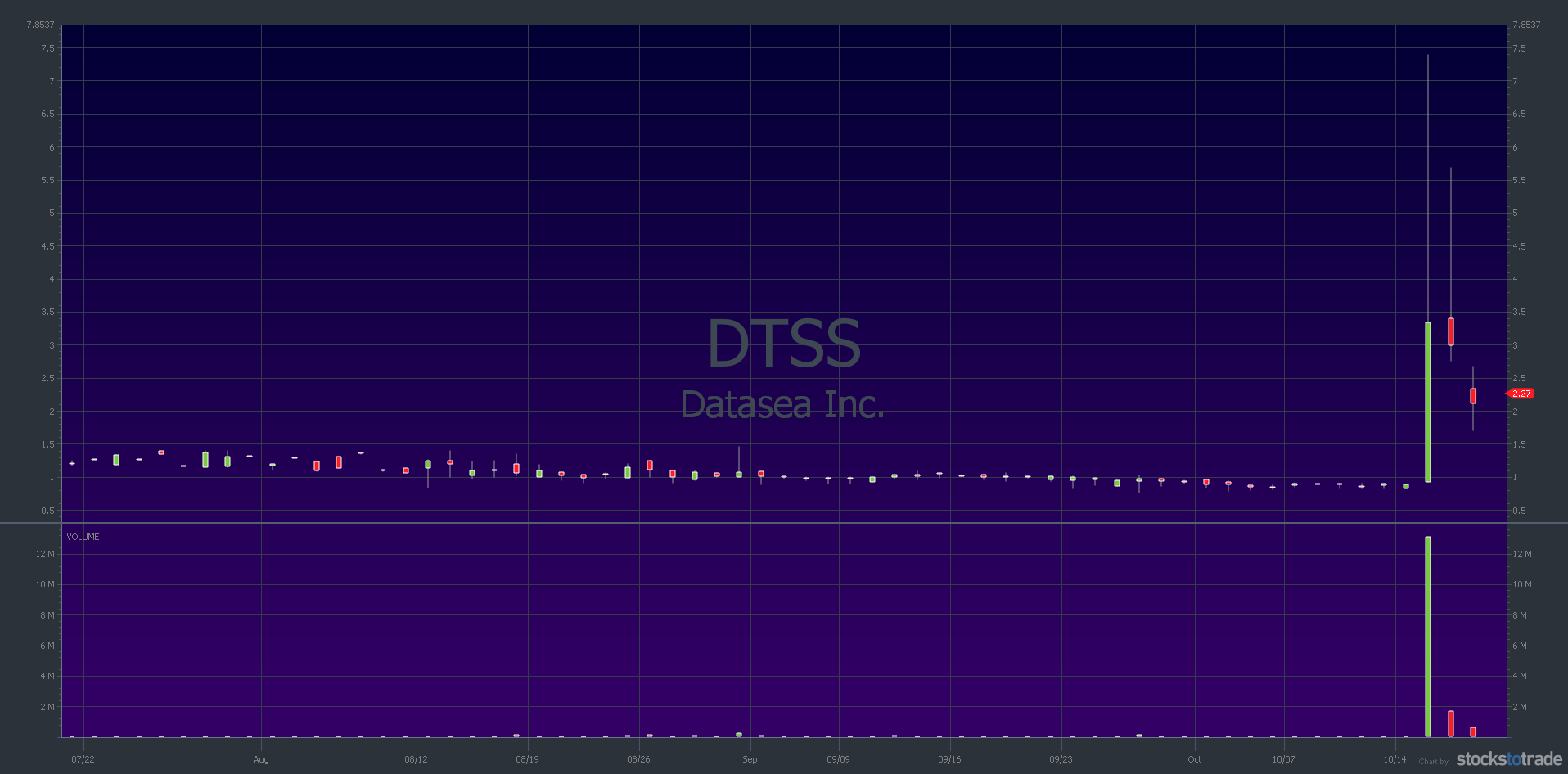
Bianano Genomics, Inc. (NASDAQ: BNGO)
BNGO spiked from less than $1 to $4.70 on October 16.
Here’s the BNGO 10-day chart:

Here are some of the comments from the Challenge Chat…
Challenge Chat October 16 BNGO:
10:25AM Ogletine: paper trade on $BNGO for $1,580. things are starting to click.
10:35AM TraderRick: wublubudubdub!!! $BNGO in at 1.25 out at 1.47.
10:44AM jobeauthement: entered another position on bngo at $1.53 for 1000 shares, out at $2.1643. Total gains of $1,104.59.
11:01AM Peachtart: OK, I’m out at 2.50 from 1.48. Holy Crap!! I made $500 today! $BNGO.
11:42AM pebblestexas: $BNGO bought at 1.27 out at 1.50 for profit of $900…wished i stayed in. $VIVE bought at 7.27 and out at 9.50 for a profit of $1065. Joined Tim’s Challenge a little over a month ago. Couldn’t have done this without the mentoring and training of Tim and his team.
12:06PM JMad: all out $BNGO 500 shares from 1.40 to $2.45 woohoo! love these low float runners.
And the three-month chart:
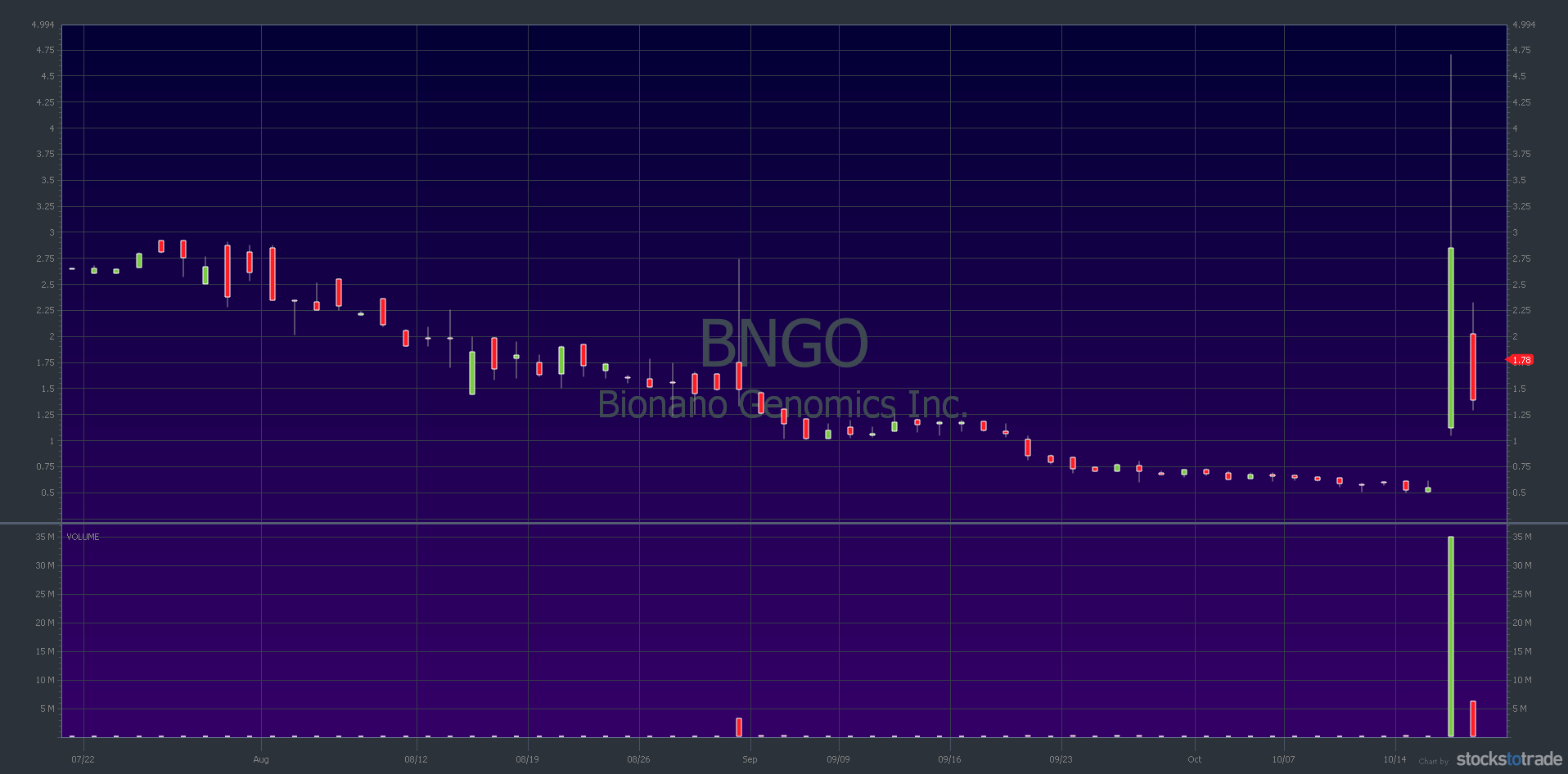
On every one of these stocks, students made solid profits on the front side. But I also want to give props to my short-biased students who trade with meticulous discipline. Huddie nailed the back side of BNGO just like he did SES…
#Playoftheday$Bngo - #Overextendedgapdown pic.twitter.com/VrZK6oNlrn
— H𝙪𝙙𝙙𝙞𝙚 (@MikeHuddie) October 17, 2020
And finally…
Viveve Medical, Inc. (NASDAQ: VIVE)
VIVE ran from the $3s to the $11s during extra hours trading on October 15 and 16.
Take a look at the VIVE 10-day chart:
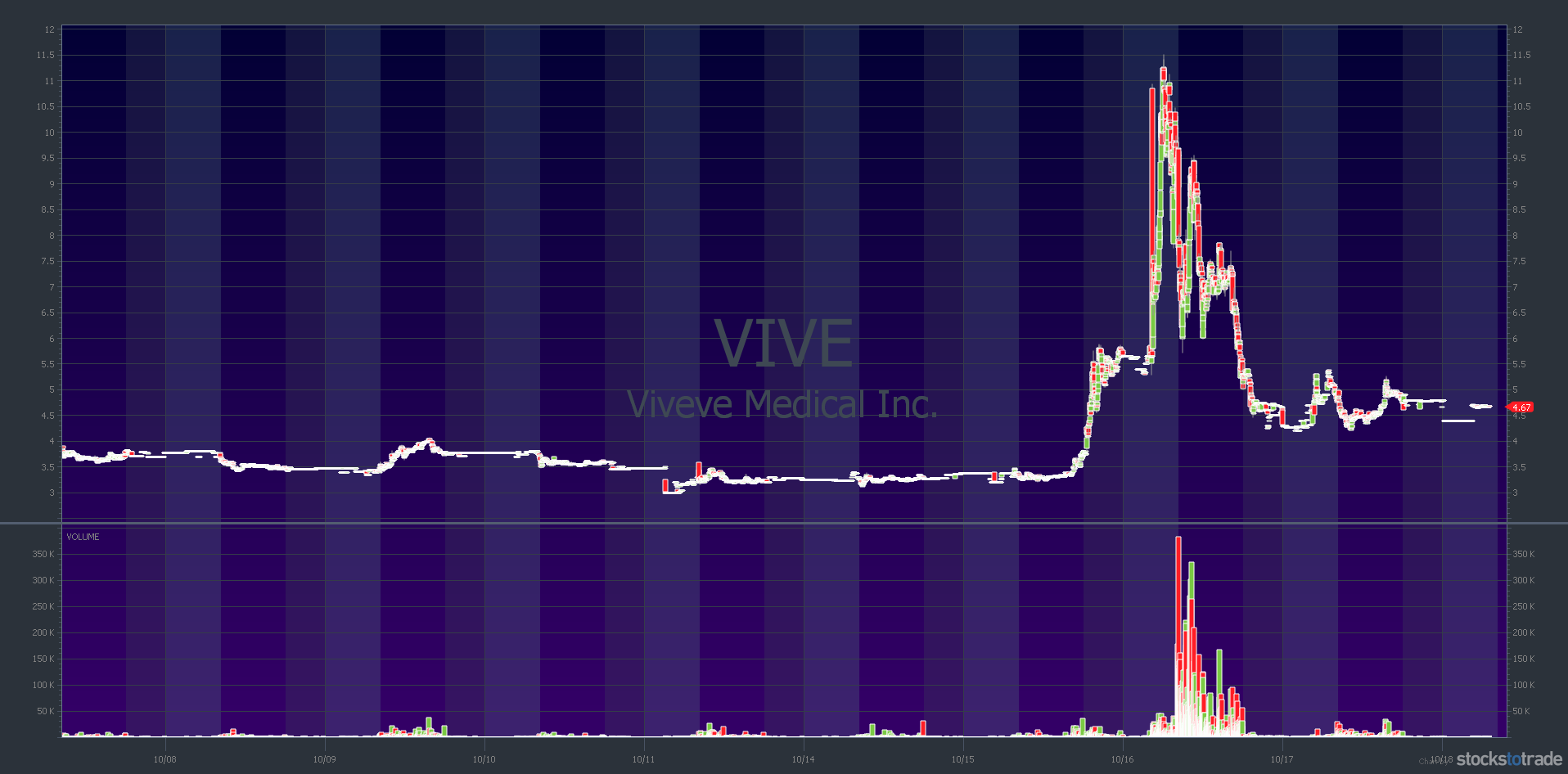
Here are a few of the VIVE trades from the TimAlerts chat…
TimAlerts Chat October 16 VIVE:
7:38AM RBI: sold 1/3 $VIVE at 7.94, looking to sell another 1/3 in the 8.20’s if it can get there again. I bought 550 shares at 5.50. sold another 1/3 at 8.35, holding the last 200 shares till I gotta leave for work haha.
7:51AM RBI: Thanks. Made 1700 on that…glad I’m out of day trades too so I can’t give it back today LOL.
08:55AM Survivor007: $ViVE in at 1.90 out 2.55 @ 500 shares.
10:17AM usmarine2daytrader: I bought $VIVE at $6.65 out at $6.94 was bouncing now almost my original exit price $8 I lacked patience but still green.
10:20AM phong84: first couple trades in a couple weeks, small loss on $IPWR in 3.88 out 3.82 and a bigger win on $VIVE in 6.88 out 7.52.
10:51AM LKScientist: In $VIVE at 7.5.. out at 8.99. 500 shares.
And the three-month chart:

I hope you can see why I love penny stocks. There’s just so much opportunity. Again, you can profit on the way up and the way down. But if you’re short biased, please, please, please beware of this…
Short Selling: Cottage Industry of Fakes and Liars
There’s a whole cottage industry around short selling. And, frankly, I’m one of the ones who inspired it because I’ve made millions shorting.
But it’s gone WAY over to the dark side…
Secret chat rooms … secret brokers … secret high net worth brokers … naked or illegal shorts … sketchy offshore brokers … sketchy hedge funds… the list goes on. And they suck newbies into a vortex.
But again, I think you’re an idiot if you’re shorting stocks like SES on the first green day. Low float. With News. On a Friday.
Our Little Secret … Don’t Tell Except for Good Friends
If you know a newbie short … don’t tell them to change. If they’re your good friend, you might want to show them this blog post. Try to help them. But, fair warning: newbie shorts are very stubborn. They think they know everything. They bring up fundamentals. But it just doesn’t matter…

A Moment of Silence for the Newbie Shorts
This is the beauty of being real. I’m not always right. I don’t know everything. But I have rules.
Shorting first green day, low float runners, on a Friday … that’s the dumbest of all strategies. Piling in on Monday because surely the stock has had its run … nope. Bad idea. Anybody who would follow these strategies has some major, major studying to do.
The risk they take is unfathomable.
So, a moment of silence for the newbie shorts. Many ripped their hair out last weekend as they battled on social media. They tried to make people see the bad fundamentals of SES. Then … well … you saw the chart.
I feel for them. But if you follow a flawed methodology and inaccurate strategies, you get wrecked. It’s your choice. You can still win as a short seller. But you gotta follow the rules and learn from someone with experience and success. I choose experience and success over naive newbies and losses.
Where do you get access to experience and success?
Trading Challenge and Pennystocking Silver
Pennystocking Silver is a monthly subscription that gives you access to video lessons, daily watchlists, and the TimAlerts chat room. You benefit from my 20+ years of experience and guidance.
Look at it this way — the SES short squeeze is not the first time I’ve seen this. And all the sympathy plays … same thing. So you can learn the rules and nuances of trading … or learn from the market. And the market is ruthless.
The Trading Challenge is my full-immersion course. Webinars, DVDs, video lessons, archived webinars. But not everyone gets accepted. There’s an interview process because my goal is to work with dedicated students. Is that you? Apply here.
Now for some serious congratulations to all SES longs from Friday and Monday. Oh, and before I forget, Monday’s move created sympathy plays. (Read about sympathy plays in “The Complete Penny Stock Course” pg. 186). So there were other stocks in the same sector, moving almost in sync with SES. I’ve included some of the sympathy play comments below, as well.

Congrats to All Students Who Played These Stocks Well
I included some of the trades above in between charts. There are so many I can’t include them all. But I want to give props to as many students as possible, so…
So first, from the Challenge chat room…
October 11, Challenge Chat:
9:48AM Popcheez: Awesome! $SES in at 3.19 out at 3.70
9:50AM GOO: in $SES 3.28 out 3.60 just 500 shares quick $155 small profits but better than a loss.
10:02AM Tommy_D: What a load of crap on $SES. In at 3.19 and out at 3.31 after watching it hit 3.90, watching 3.60 hold, seeing VWAP hold and bouncing, then big red candle. Cut bait as it crossed below VWAP.
2:30PM benhook: Officially got scared out of $SES. sold @ 4.49 from 3.60, 300 shares.
3:46PM arturoil710: This trading thing is Hard!!! I was in at $4.19 $SES panic sold at $4.30 cus i lost patience, and now its making the move i was looking for.
3:52PM JRF: Bought $SES at 4.20, sold at 5.10. profit of 179.94.
3:57PM CharlieTango: Long $SES 1100 shares at 4.33 out at 5.38. I’d say that was a dAM good trade.
5:38PM Griff: $SES chuffed to high hell with my 14.8K gain today. Bought around 1.45 initially when it confirmed. Ended up making multiple trades. I gave some profits back through over trading. Room for much improvement but happy with the patience in recent weeks coming to this nice little gainer.

October 14, Challenge Chat:
Remember, there were sympathy plays on Monday. So I’ve included trades from the best one, NF Energy Saving Corporation (NASDAQ: BIMI). And also one or two from YUMA.
9:42AM LegalPimp: i already longed $SES once at open…..bought the dip at 9.55 and sold at 10.15.
10:37AM oskbmb: made $55 on $SES.
12:33PM Trade4us: $BIMI in at 4.25 out at 5.75 small position.
12:41PM alexbricker: 500 $BIMI - in at $4.10 out at $6.10.
1:18PM RD52: In $YUMA @ 4.28 out at 5.52. A small win.
1:53PM PapaD → timothysykes: $SES, $BIMI, and $YUMA have been great mental wins for me, and small actual profits too. But the lessons I’ve been able to capture since last Thursday, have been so valuable… more than the missed profits. My level of confidence has been elevated. Thanks Tim. Just what I needed after the TI summit.
2:01PM SatelliteIncomeUnlimited: made 769.00 on BIMI.
2:07PM Jackaroo: $YUMA 1k 4.80 (see 3:37 time stamp for exit).
2:12PM arturoil710: all out $BIMI $761 profit in at $7.50 out at $9.00 avg.
2:20PM the_tipsy_nomad: Traded $BIMI for the second time today, 1000 shares in @7.25 and out @9.29 adding another $2000 to my days gains. Incredible Monday.
2:28PM arturoil710: Congrats to all Longs on $SES and $BIMI and if you didnt make money today, just remember there are shorts who are stuck on $SES from $5 and below.
2:51PM JMad: All out BIMI from 2.99 to 8.3! Woot!
2:54PM RD52: Not easy to trade $BIMI for a gain now. Scalped it. In at 8.45, out at 8.65.
3:25PM EHodge: $BIMI in at 5.30 out at 8.30 after it fell from nine i was anxious to get out and take profits was hoping for a break of day high when in doubt get out.
3:37PM Jackaroo: flat on everything energy for +$750 - except holding $GBR overnight if it closes above my entry of 1.70.
4:22PM keeyongtn: $BIMI in at 2:12 PM at $9 out at 4:10 PM $11 500 shares, scared to hold overnight.

October 15, Challenge Chat
9:40AM RBI: out last third of $BIMI at 10.60….crazy what you can make when you wait for the market to come to you. Doubled my money yesterday and today on 3 trades (small positions but still!)
10:35AM ejroyce: Very first profit ever, thanks Sykes, Grittani, others here, I’ve learned quite a bit. I caught a falling knife and didn’t bleed.
3:04PM greenking49: out $SES about +200 i am ok with that.
3:48PM tfife: was able to grab me a small piece of $DTSS . in at 3.10 out at 3.40.. one of my first trades as a new Challenge student.
October 11, TimAlerts Chat
8:50AM RouxBourbon: OUts $SES at 3.50 for a $50 gain, I will take it on a 100.
9:47AM Gettingrich91: $SES in @ 3.10 Out @ 3.55.. Keeping it safe.
9:49AM BigDreDay26: $SES in at $3.24 out at $ 3.78.
9:50AM carlosmezagomez: $SES in @3.23 out at 3.70, before everyone started sell.
9:51AM TinCup72: $SES in @ 3.16 out @ 3.63. I know I’m going to leave some on the table but I took my profit and ran.
10:06AM joeylowe: 3 trades (2 premarket) on $SES. +2700. Enjoy your weekend traders and remember don’t force your trades. It’s a whole lot easier to make money when you let the trade come to you.
11:39AM jaromau: $SES in at 3.19 out at 3.25 should have taken the 10% when i had the chance. oh well live and learn. will not be so greedy next time.
October 14, TimAlerts Chat
9:36AM hAM 159: in $SES at 10 out at 10.5 lol wtf this thing is crazy.
9:36AM Big482: I got scared and sold $SES for $48 profit.
9:38AM InternationalLegend: $SES SOLD AT 10.19. $40 profit.
10:13AM EAdapon: in $BIMI at 2.74 out at 3.15. 1500 shares.
10:14AM slettebak: $BIMI bad entry 2.67 sold 3.13.
10:14AM sgoodall31: $SES bought at $8.50 out at $9.83.
10:23AM keeyongtn: Just sold $SES at $11 in at $10 heart was pumping so fast had to take deep breaths.
10:23AM J_Freedom: $BIMI in @ $3 out at $3.25 +8%.
10:32AM Survivor007: $BIMI in at 3.05 out 3.55 / 150 shares
10:40AM schultzy: was in $BIMI at $3.00, out at 3.75. 200 shares.
10:44AM CAPOmg: BIMI in at 2.98, out at 3.22.

10:47AM Yoshling: $SES at $13.6 was my goal for the day lol but sold long time ago… oh well still up $3000 on $2400 since friday afternoon.
10:48AM vnickn: $SES in at 8.30, sold half at 13.3.
10:56AM vnickn: $SES in 1000 at 8.30, out avg 13.35 +5062 on the day.
11:01AM charan: In $BIMI at 370 sold at 4.25.
11:24AM Yoshling: I just made $50 on my locked in $200 $BIMI gamble lol… no day trades left so tiny position.
11:26AM Slayertrade: dip bought $BIMI at 3.79 out at 4.40.
11:37AM stevenpalomino: made 5.52% on $BIMI & $GNUS trading with super small account so only $9.43 but wanted above 3% and it was my very first LIVE trade.
11:40AM Survivor007: $BIMI in at 4.70 out 5.50 / 150 shares.
11:43AM Duffle_duff: almost sold $BIMI for a loss at $3.83, held and got out at $5.00, in at $4.23, solid %12 gain.
11:43AM Gobucks: $BIMI bought 200 at 3.8 sold 100 at 4.6 and 100 at 5.3.
11:45AM womda: $BIMI 3.90-5.36.
11:48AM jadiez: $BIMI @ 3.85 out @ 5.49.
11:59AM matthewwhitell: Made 400$ off bimi so far.
12:10PM matthewwhitell → zzaznhan626zz: I got in $bimii at 3.80 with 200 shares. But I also got in at 2.60 the first time. And broke even when I tried trading in a second time. I’d say I traded it 4 times today. But I’m done now took my profit and run.
1:23PM AnsiCartman: $BIMI in at 5.8 out at 5.85, $SES in at 10.15 out at 10.22, wow im really bad at this.
1:24PM sgriever3: bought $bimi at 6.36 500 shares out 6.80.
2:06PM sgriever3: bought $bimi 8.25 out 8.62 small position.
2:10 PM GooniesTrader81: Trading is frustrating. $BIMI 150s at $6.16 out at $6.46. 3 minute trade. Sold WAY TOO SOON! I keep telling myself to let me winners run longer but I don’t. $BIMI now at $9. I’m glad I was on the right track again and again.
2:11 PM Hardybrian1: Sold BIMI - in at $4.00 and out at $9.46 with 2,000 shares… hoping for a nice pull back to enter an overnight play.
2:17 PM nburton20: went in at 8.5 this morning for $SES… I now AM in shock! Sold at 10.10 before the spikes because i had stuff to do today😂.
3:16 PM Yoshling → CKP111: I had $2400 friday morning dipped to $2000 and now I AM at $6100 lol… I literally could have made so much more.
3:20 PM FutureKin_g: Caught that $BIMI dip WOW so SCARY in @8.29 and out @9.14 for small gains.
4:03 PMcharan: sold and bought $BIMI 4 times today roughly made around $500 happy about it.
4:10PM Androo: $BIMI in at $10.08, out at $10.89 solid a/h b/o trade, just like $SES Friday.
4:21PM vnickn → charan: im holding from 5.60…. cuz no day trade…. stupid decision on my part but as of now im up +8400. Got lucky. I would to take profits lol.

October 15, TimAlerts Chat:
7:15AM Moavran: jeeeeeez - what a monster. Held 600 $BIMI @ 8.75 and just sold @ 12.65 #meatofthemove … Nice $2k gain.
9:34AM vnickn: $BIMI in 1500 at 5.60, out 10.2 +6900. Between yesterday $SES and today +12,000.
9:47AM HammsKC: in $SES 12.95 out 13.17 tried for that bounce when it looked like it was staying around 13 but just wasn’t going strong enough to $110.
9:50AM Normunds95: dip bought (paper trade) $WWR at 7.04 out at 7.62, 5 seconds later it spiked $1/share, but ok, I was right on my thesis and it reached my goal had I have been holding a bit longer …Thank you Tim! Things finally start to align for me.
10/15 12:57PM Neverhood2019: Fuf… $WWR. Dip buy In - 5.76 out - 6.69. So nervous for me. I still buy too early.. 500 shares and $465 profit.
10/15 3:22PM BlackWolfTradingCo: Done for today gang. +250 or so on the day. Until tomorrow.
11:15 AM Bobbemornee: second order of BNGO SOLD, IN 1.45, OUT 2.43, 100 share! thanks all!
12:47 PM GooniesTrader8: Studying breakouts for months is now paying off. BNGO 300s $2.67 out at $3.30 $190. A good win after beating myself up for selling SES and BIMI wayyyy tooo soon earlier this week. Now back to work. 🙂
October 16, TimAlerts Chat:
10:05 AM GoldengirlDTSS: in at 4.13, out at 4.45 for a quick $220. It seemed like it halted for so long that I got out BUT now it’s up to $5.06. Still learning…
10:24 AM AnigaiMyB: DTSS +24% trade has me too happy with myself right now. I may be influenced by some misplaced overconfidence were I to continue. No more for me today, time to step back, watch and reevaluate.
Tweets
Again, there are so many. I’ll include several here, but you can see more by going to Twitter and searching “@timothysykes $SES.” If you want to check any of the other stocks mentioned in this piece, do the same search like this: “@timothysykes $TICKER.”
It’s pretty crazy…
@stevenshatton:
Made $1200 on $SES. Studying really pays off! @timothysykes
— Steven Hatton (@stevenshatton) October 11, 2020
@BarryWixson
$SES in @ 3.90 out at 7.98 with 73 still riding. @timothysykes FINALLY!!!!!! $1300 profit locked…. couldn’t have done this without you buddy!!!!! pic.twitter.com/XBFFXaLQKU
— Pump-N-DumpChump (@BarryWixson) October 11, 2020
Sold my remaining 73 of $SES.$598.98. Total trade profit of over $1898. Time to Educate and Replicate. @timothysykes Maybe the 6 years in Minneapolis rubbed off lol. I’ll take singles all day…study time. #ThankYou pic.twitter.com/ADxgl2KMvk
— Pump-N-DumpChump (@BarryWixson) October 14, 2020
@EwenLaing
Patience pays off!
Super happy I saved some trades for $SES today. $3.67-$4.55 & $5.15-$7.85 AH.
Cheers @tbohen @timothysykes @StocksToTradePro.— Ewen Laing (@EwenLaing) October 12, 2020
@INceNY1:
I’m so happy & upset in the same time. Finally market getting back $SES was amagzing.But I got message from 2 friends they blow up their accounts. One more time KNOWLEDGE Is EVERYTHING. STUDY HARD & FOLLOW @timothysykes rule about shorting on #Friday to low float stock.@profitly
— ERIC INCE (@InceNY1) October 12, 2020
@TessaLamping
Credit… I only did 10 shares.. BUT after losing my discipline yesterday I had to scale back a bit. I studied @timothysykes dip buys last night, waited for the 3rd dip to buy $SES. Trusted myself. Bought at 12.80 and sold at $13.40. Happy with my plan 👌😊👩💻 pic.twitter.com/WyNIbf3MLu
— Tessa (@TessaLamping) October 15, 2020
@Kitembadas:
Made $141 on $SES on a $289 account making 49% profit
Made roughly $102 on $SES on my $450 account making 23% profit.
Bought $BIMI twice but came out even..Thanks for the small account incentive. Great for learning process @timothysykes pic.twitter.com/yjXhFg50vQ
— José Kitembo (@Kitembadas) October 14, 2020
@DanteBenton2:
Bought $SES Friday into the close at 5.42 out at market open at 10.15 almost a 100% return on my money!!Thank you! @timothysykes @timbohen This is how you grow a small account!! ✊🏾
— Redtrader01 (@DanteBenton2) October 14, 2020
@Jonk87:
Caught a tiny part of $SES for $650 but not chasing anything just take meat of move as @timothysykes teaches - not risking shit with this lil float
— Stephen Johnson (@Jonk87) October 15, 2020
@nawkker:
$SES $BIMI I used to look at charts like these (with lines all over the place) and squirm. Now, I will never go back.
thx @timothysykes @madaznfootballr @rolandwolf86 @Steven1_994 🙏🙏
only 1 of 4 longs worked for me today lol, but initially lost $400, & yet came back +$400. pic.twitter.com/sAyjm7RFST
— nawkk (@nawkker) October 14, 2020
@BeckyBr3198000
Made my first profit today $55 in 5 minutes on $SES… thanks @timothysykes for teaching me!!! I put into practice your teachings and disciplined myself! Yay
— Becky Brandt (@BeckyBr33198000) October 14, 2020
[Please note these results are not typical. These traders have exceptional knowledge and skills that they’ve developed with time and dedication. Most traders lose money. Trading is risky. Do your due diligence and never risk more than you can afford.]
What do you think about the SES short squeeze and full-on Supernova Season? Comment below, I love to hear from all my readers!
The post Lessons from the Short-Squeeze Supernova Season appeared first on Timothy Sykes.
Share Market
FAQs for First-Time Resellers
How can I start my reselling business online?
Reselling liquidation lots can be a fun, fascinating, and profitable business. Many people would like to get in on such a venture but don’t know where to start.
The first and most important step is to determine what your niche will be. “Reselling liquidations” is far too broad for a brand new business, so you’ll want to narrow it down a bit. You may choose to resell items in a particular category such as clothing, electronics, or home goods. Some prefer to instead target resales from a specific retailer. If you choose to pursue this route, it’s best to select a retailer with a focus such as a home goods store or an electronics seller, rather than a broader catalog of general merchandise like Amazon or Walmart.
Once you’ve determined your niche, it’s important to research it thoroughly. Familiarize yourself with the types of products you’ll be selling and the current trends surrounding them. Find a good source of information on the direction your products are heading so you can anticipate coming changes in your market.
Finally, you’ll want to figure out where and how you will resell the items. Will you make them available online or have a physical presence in your town? There are a number of websites that are excellent for resellers such as eBay and Amazon. For local businesses, it may be best to start out with a stall at a local flea market or consignment mall.
When is the best time to start my reselling business?
While liquidation lots are available year-round, and it’s possible to start a resale business at any time of your choosing, it’s widely accepted that January is the best month for liquidation auctions. This is because retailers have a huge number of post-holiday season returns to process and many of these are still brand new products in perfect condition. Additionally, many retailers are liquidating merchandise they only carry on a seasonal basis, as gifts for the holiday season. For this reason, you’ll find the best selection of inventory, and often the highest discounts too, because of the sheer number of auctions going on after the first of the year.
What products can I sell to make money?
The truth is, almost any nonperishable good that is for sale in a retail store can also be found in a liquidation auction. Here is a list of some of the most common categories:
- Apparel, Footwear & Accessories
- Appliances
- Automotive Supplies
- Books, Movies & Music
- Cell Phones
- Computer, Equipment & Software
- Consumer Electronics
- Furniture
- Grocery
- Health & Beauty
- Home & Garden
- Industrial Equipment & Building
- Jewelry & Watches
- Mixed Lots
- Office Supplies
- Toys, Kids & Baby
- TVs
What retailers should I consider purchasing returns from?
The good news is that there are dozens of top retailers and manufacturers who sell returns and other products through liquidation auctions. One good approach is to focus on a retailer you shop regularly. This way you will likely be more familiar with the types of products they carry and better able to gauge the market. Some of the most popular include:
- Amazon
- Best Buy
- CVS
- GameStop
- GE Appliances
- Eddie Bauer
- JC Penney
- Lowe’s
- QVC
- Sam’s Club
- Nordstrom Rack
- Target
- The Home Depot
- Walmart
- Wayfair
- Unilever
Where can I purchase goods to resell on my own?
The B-Stock network is an excellent place to start. Our sourcing network features liquidations from dozens of leading manufacturers and retailers. We offer returns, liquidations, and overstock auctions as well. With our large selection, you’re sure to find plenty of auction lots to fit your inventory needs and your business budget. And since our network is so vast, you only need to apply for a reseller account once to gain access to auctions of all sizes and price points, located in warehouses across the country.
How much money can you make reselling goods online?
Some seem to believe that reselling auctioned goods online is a quick and easy way to make a buck. While it’s true that this can be a lucrative business, it can also be a lot of hard work, so it’s best to go into it with a good understanding of the process and its requirements. The best way to maximize your profits is to do plenty of research before you begin. Understanding your market, your target buyers, reselling requirements, and the sites you’ll be selling on is key. The more information you gather about your business before you begin, the better prepared you will be and the more likely you are to make reselling a success.
B-Stock works with nine of the top 10 U.S. retailers to help resell their returns, overstock, and other liquidation merchandise. We have dozens of private retailer marketplaces across different categories and conditions to suit your business inventory needs.
The post FAQs for First-Time Resellers appeared first on B-Stock Solutions.
Share Market
Investing in Equity for Beginners and Small Investors
How should a beginner or a small investor invest in equity?
The answer widely available and promoted widely is ‘SIP karo’-invest in mutual funds through SIP.
Even if you have some lumpsum to invest chances are that you will be told “don’t take the risk of investing in one go, SIP karo”.
Some will suggest a few funds with the “best past returns”. And then quickly you will be told how simple it is to invest in MF, “App download karo aur invest karo”
For some reason, beginners and small investors are expected to be satisfied with these answers-answers that may be right if all you can invest in a few thousand every month but not if your lumpsum and monthly savings are a more than that.
Yes, it has become very easy to buy MF but it is not easy to invest in it successfully.
Challenges faces by new investors
- May want to invest in stocks but most advice is only on mutual funds.
- Need to deploy their lumpsum savings but most advice is on SIP in mutual funds.
- Everyone agrees that selecting mutual funds based on past performance is inadequate and incorrect but most advice is based on past performance.
- Market is ever-changing but most advice is one- time
- Selection and Portfolio management is not simple enough
- Don’t really learn how to invest in equity
There is a need for an investing solution beyond SIP in MF for beginners and small investors. So we decided to design a solution that addresses all the above challenges faced by them.
For whom: If your total investment i.e the lumpsum + 12 times the monthly savings you want to invest in between 1 to 5 lacs you need a better solution to investing than SIP in MF. Read on
What do you need? You need to invest your lumpsum and monthly savings in Stocks, Mutual and Index funds. You need to manage this portfolio i.e. buy, sell or hold these as the market goes through it ups and downs. And you need to do this with some understanding of the process and not just act blindly on someone’s recommendations.
Stocks, Mutual and Index Funds all have their advantages and with proper guidance, you can take advantage of all of them.
What are the benefits of investing in Stocks?
Investing in individual stocks gives you a higher level of control over your portfolio, where you can choose your allocation based on a specific industry and quickly exit once you earn a sizable profit. Since you are in control, there are no additional overheads like fund manager fees. Finally, your decisions are not impacted by external factors as is the case in a Mutual Fund, eg redemption pressure, large inflows, fund manager exit, etc.
What are the benefits of investing in mutual funds?
Mutual funds help you diversify easily with a very small investment. A typical MF holds around 50 stocks in its portfolio, thus presenting lesser risks if one stock was to perform poorly. A dedicated fund manager who understands the Indian markets actively monitors and oversees the fund so that inexperienced investors don’t have to sweat it. MFs make it easy for beginner investors in India to follow a disciplined way of investing through.
What are the benefits of investing in index funds?
An Index Fund is a mutual fund where the portfolio of stocks is not actively selected by a fund manager but is a replica of the Index eg the Nifty 50 Index Funds’ portfolio matches that of Nifty 50. Mutual funds are called actively managed funds while investing in index funds is called Passive investing. The advantage of an Index fund is that its portfolio is predictable and it comes at a lower cost. So you get the benefit of diversification at a lower cost. However, the decision to invest in Index funds is similar to any mutual fund.
How do you invest in Stocks, Mutual and Index funds?
The answer is Think Portfolio! Ensure you have a diversified portfolio of strong companies and MFs.
But how do you select the few for your portfolio from amongst a larger set of strong companies and MFs. The answer is you select the ones which have an attractive upside potential over the next 3 years.
This prevents you from buying at expensive prices-thus avoiding the risk of mediocre returns and sharp fall in case the market/stock corrects for whatever reasons.
Why 3 years? So you choose like an investor-expect growth from the company’s performance and not the market price movement (which is a trader’s mindset) which is a bonus when it happens.
How to implement this?
It is not feasible for a beginner to screen stocks and MFs and select the ones to invest in. This is the job of your advisor. However, you should not be expected to follow someone’s advice blindly. What you need is to understand the process followed in making the recommendations and enough transparency to know that due process has been followed. This will enable you to invest confidently and stay invested.
When we search for a solution based on all the above- advice to build a portfolio of stocks, mutual and index funds to invest both lumpsum and monthly savings and provided transparently; we found that there is nothing available for beginners and small investors. So we decided to build one
MoneyWorks4me PRO
With PRO you will be able to invest
- In a portfolio of strong company stocks with an attractive upside potential
- Lumpsum in a set of funds with attractive upside potential
- SIP in a set of funds with different investment styles
You have the flexibility to choose where you wish to invest and how much. We recommend investing your lumpsum equally in the stock portfolio and in MFs for better returns and a diversified portfolio.
The PRO Dashboard is designed to give you the most important decision related information right there
- For stocks, you can see how it is rated on its 10-year performance, Future Prospects, and its Upside Potential.
- For MFs you can see its Investing Style (Momentum, Quality, Value, Small Cap), Fund Quality (as compared to other funds) and it Upside Potential
An analyst note explains the rationale for the recommendation in brief. And you will be able to get further details when you click the stock or fund name.
You can also do the stock transactions from the PRO Dashboard.
If your trading account is either ICICI Direct or available on the smallcase gateway (Zerodha, HDFC Sec, IIFL, Edelweiss, 5 Paise, and Alice Blue) you can safely and conveniently complete the transaction using the APIs on the PRO Dashboard.
This convenience enables you to SIP in the stock portfolio if you do not wish to SIP in MFs.
Finally, when you transact from the PRO Dashboard your portfolio is automatically updated in the Moneyworks4me Portfolio Manager (which has many benefits).
Visit the site to understand PRO better and see a video of how simple it is to use.
Click here to view our plans and sign up.
Need help on Investing? And more….Puchho Befikar
Kyunki yeh paise ka mamala hai
Start Chat | Request a Callback | Call 020 6725 8333 | WhatsApp 8055769463
The post Investing in Equity for Beginners and Small Investors appeared first on Investment Shastra.
Share Market
What does a reverse stock split mean for investors?
A reverse stock split can benefit a corporation and an investor. This TradingSim article will explain what that action is. In addition, this article will also explain how reverse splits from large corporations benefit new investors. Also, this article helps investors to rebalance their portfolios in this bear market. This article can also help investors improve their trading strategies.
What is a reverse stock split?
A reverse split is a corporation’s decision to reduce the number of its existing shares. With that action, a company splits its stock into fewer shares. Because companies sell fewer shares to investors, they enable certain actions. When a corporation has reverse stock splits, companies make their shares more valuable.
Why do companies reduce shares to sell investors?
When a corporation has a reverse stock split, there are many reasons for that decision. When a corporation’s stock falls, it’s in danger of a delistment from the New York Stock Exchange. If there’s a delistment, a stock becomes a penny stock. To avoid that fate, a company makes fewer shares available to raise the share price. Stockholders vote to approve the measure.
While corporations have reverse stock splits because of negative reasons, there are positive reasons as well. If a corporation plans to have a spinoff company, a company can reverse split its shares to increase share price. Then, a corporation can spin off into another company to gain a higher share price.
What different kinds of reverse splits exist?
Just as stocks have different prices, some reverse stock splits have different ratios. For example, a company has a 100:1 reverse stock split. In that case, every 100 shares a shareholder has converted to one share.
In one example, an investor can have 100 shares of a company at $10 a share. After a reverse stock split, every 100 shares changes to one share.
With 100,000 shares before the stock split, the market capitalization is $1,000,000. With a 100:1 split, there are now 100 outstanding shares.
The calculation is as follows:
1,000,000/100-1,000.
Each share is now worth $1,000.
Does a reverse stock split affect a company’s worth?
While a reverse stock split may change an investor’s perception of a company, it doesn’t affect a company’s overall value.
Ryan Sterling is the founder of Future You Wealth in Manhattan. He noted that a company’s reverse stock split changes “are cosmetic. “They don’t say anything about the fundamentals,” added Sterling.
He also said that any psychological benefit from reverse stock splits is short-lived.
“Any enthusiasm you feel from a stock split, I would take with a whole lot of caution. When you talk about money in the stock market, the biggest eroder of wealth over time is human emotions,” said Sterling.
How is a reverse stock split different from a stock split?
While a reverse split means fewer shares for investors, a “regular” stock split does just the opposite. When a company takes that action, they make more shares available to investors. In a recent example, Apple recently announced it would have a stock split in August. Through a statement, the tech company made the decision to “make the stock more affordable to a broader base of investors”.
In Apple’s 4- for- 1 stock split, four shares sell for the price of one. As a result, if investors buy Apple stock at $ 400 a share. In this new 4-for-1 split, investors can buy one share for about $100.
Is a reverse stock split bad for investors?
When corporations have reverse stock splits, they sometimes have negative consequences. Financial expert Bill Matthews had one example of a company’s stock falling after having a reverse stock split.
“I was talking with a friend about a stock that he had bought at $1 per share. Shortly after he bought, the price fell to $0.50. A few months later, he received notice that the company was planning to implement a 1-for-10 reverse stock split. He was wondering if that reverse stock split was a good or bad thing,” said Matthews.
“According to the company’s press release, the reverse stock split of 1 for 10 would bring the stock price up to $5 per share, and that would prevent the stock from being delisted from Nasdaq. I ran into my friend a few weeks ago and asked about the stock. The stock, which was selling at $5.00 after the reverse, is now selling at $1.25 and he is down 88%,” added Matthews.
“In this case, the stock moving from $0.50 to $5.00 overnight was just an accounting ploy. The company still had very shaky fundamentals. Savvy institutional investors won’t invest in the stock just because its price suddenly soared, and it will have a hard time raising capital if its balance sheet is poor,” said Matthews.
“Shorters, who follow reverse stock splits and target those stocks, began to put pressure on the stock price, sending it tumbling. As selling pushed the price downward, other investors panicked and sold, causing the price to plummet even lower. As my friend discovered, a reverse stock split is normally not good news for shareholders,” added Matthews.
What should investors do when a company has a reverse stock split?
When a corporation has a reverse stock split, Matthews advises investors to review a company’s balance sheet if it reduces available shares.
“If a stock in your portfolio announces a reverse stock split, take a good look,” said Matthews.
Matthews notes that if a corporation’s “fundamentals aren’t healthy, you might be better selling your shares. If you really like the stock, chances are good that you can buy back those shares at a much lower price several months down the road.”
However, if a company’s balance sheet and past earnings reports are strong, Matthews notes that investors should hold those stocks.
How does Apple stock split affect investors?
As a result of Apple’s split stock decision, many financial experts see it as a good sign. Caleb Silver is editor-in-chief of Investopedia. After Apple’s announcement, he believes that Apple’s decision will attract more investors to its stock.
“For popular stocks like Apple, the lower share price makes it attractive to investors who couldn’t afford higher share prices but want to own a piece of the company. Stock splits are seen as a sign of confidence from a company,” said Silver.
In addition, he added that Apple’s stock split is “considered a response to more demand for its shares from investors.”
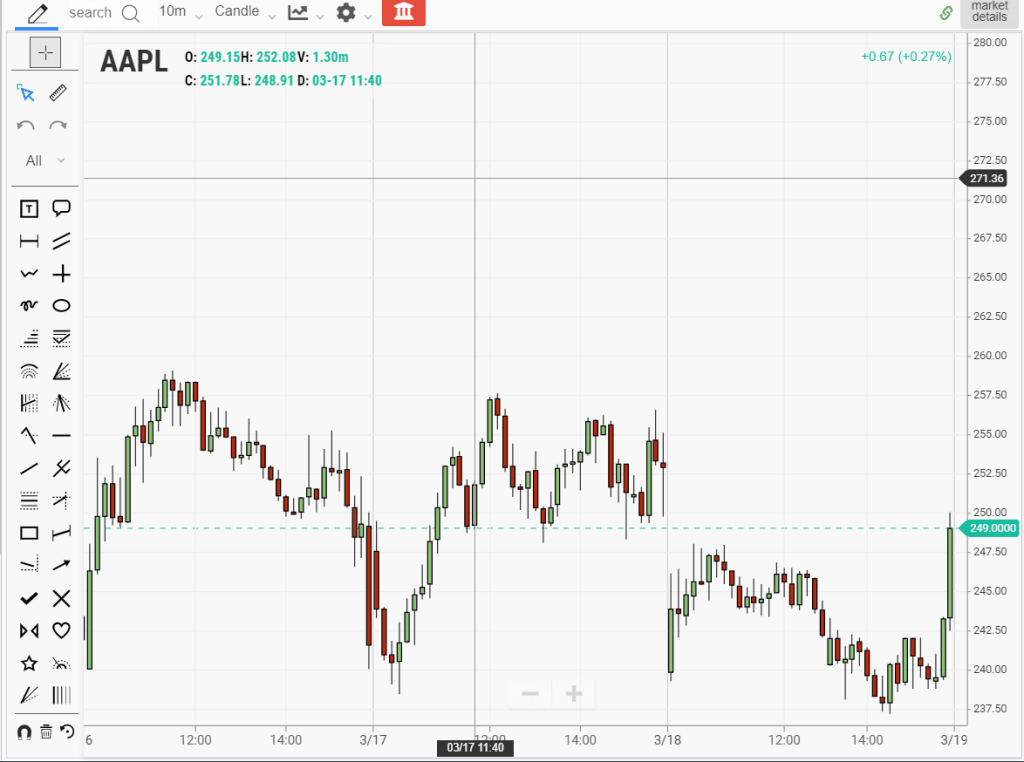
Sterling doesn’t think that Apple’s stock won’t be affected by the stock split. He believes it “effectively increases demand for people who don’t understand fractional shares,” Sterling said. “If anything, it causes more volatility in the stock.”
Will Apple’s stock split impact the stock market?
While Apple’s stock split is gaining attention, financial experts say it won’t change the company’s value. Max Gokhman is head of asset allocation at Pacific Life Fund Advisors. He doesn’t think that the stock splits will affect its share price.
“To be crystal clear, however, and as proven by grade school algebra, stock splits have no impact on the value of a company,” said Gokhman.
Financial editor Ric Edelman also thinks that Apple’s value won’t be affected by the recent stock split.
“This is not a financial event and has no economy implications or bearing on the value of the investment or the outlook for Apple as a business. It’s a non-event,” said Edelman.
“This is a huge event from a psychological perspective. That’s the reason companies engage in stock splits — they know it plays on the emotions of investors,” added Edelman.
Edelman also advised investors to ignore Apple’s stock split and invest in other assets.
“You should ignore this and instead invest in diversified stock mutual funds,” said Edelman.
Rite Aid stock rises after reverse stock split
Rite Aid (NYSE:RAD) is a company that had a reverse stock split in 2019. The pharmacy chain made the decision to avoid a delisting from the New York Stock Exchange. Rite Aid’s stock was in danger of falling below $1 before the reduction of available shares.
As a result, Rite Aid had a 1-for-20 reverse stock split. Every 20 shares of Rite Aid stock is converted into one share. The share will be 20 times the original price. While the stock briefly rebounded after the split, the coronavirus crisis caused Rite Aid shares to increase.
In addition to being part of a White House COVID-19 response group, Rite Aid is expanding its services. Many pharmacy locations will also be coronavirus testing centers.
While Rite Aid will expand services, the company noted in a statement that its “current supply of generic medications is presently sufficient and the company does not anticipate any significant near-term supply chain disruptions that will affect its ability to fill prescriptions.”
Rite Aid’s Q1 2020 earnings rise above expectations after reverse stock split
Rite Aid’s Q1 2020 earnings report exceeded Wall Street expectations. In the last quarter, revenue was $6.03 billion. That’s an increase from $5.37 billion in Q1 2019. Rite-Aid’s CEO, Heyward Donigan, spoke about the positive results.
“There are certainly challenges brought about by COVID-19, including the decline in acute prescriptions and increased costs incurred to assure the safety of our associates and customers. No matter the challenge, we can execute our strategy and deliver day-to-day operational excellence in the face of a pandemic,” said Donigan.

“I am amazed by the passion and spirit of our more than 50,000 associates, who have come to work every day driven by a desire to help customers stay healthy and demonstrating the essential role of pharmacy in our communities,” added Donigan.
Donigan also spoke about the importance of Rite-Aid’s pharmacists and new initiatives during the COVID-19 era.
“Thanks to their hard work, the fundamentals of our business are strong, and we are right on track with the launch of our new RxEvolution strategy. I am excited to continue this important work as we look to become a leading mid-market PBM, unlock the value of our pharmacists and revitalize our retail and digital experiences,” said Donigan.
Rite Aid’s reverse stock split ultimately brought the corporation from the brink of bankruptcy.
Booking Holdings survives reverse stock split
Bookings Holdings(NASDAQ:BKNG) is another company that survived after a reverse stock split. When the corporation was still called Priceline, it made a decision to have a 1-for-6 split in 2003.
COVID-19 affects Booking Holdings Q1 2020 earnings
While the online trip booking company rebounded after its reverse stock split, coronavirus disrupted that growth. In its Q1 2020 earnings report, Glenn D. Fogel spoke about Booking Holdings’ disappointing results.
“Revenue declined 84% versus last year, and we recorded an adjusted EBITDA[ earnings before interest, taxes, depreciation, and amortization] loss of $376 million, the first time we have produced a quarterly EBITDA loss since 2001. We witnessed the greatest negative impact from the virus in April as newly booked room nights in that month declined over 85% year-over-year,” said Fogel.
While travel declined during the worldwide quarantine, Fogel noted that Booking Holdings’ revenue improved slightly. He noted that trip bookings rose after the economy opened up again in late spring.
“After April, room night trends have steadily improved. The improved booking trends were primarily driven by domestic travel, with international trends seeing much more limited improvement,” said Fogel.
“While almost all of our global markets showed improvement through the quarter, Europe and the United States had the highest contribution to the improved domestic booking trends,” added Fogel.
Some financial experts bullish on Booking Holdings after reverse stock split
When the U.S. State Department lifted global restrictions, Booking Holdings stock increased 1.5%. Steve Chiavarone is a portfolio manager and equity strategist and vice president at Federated Hermes. He noted that the Booking Holdings stock bump may not last because Americans are still afraid or unable to travel.
“But you still have restrictions on Americans coming in, and I think ultimately, people aren’t just staying home because of mandates. They’re staying home because they’re worried about their health,” said Chiavarone.
“I think for a lot of reasons, you’re still going to see travel levels down. I think you’re still going to see a preference for domestic travel. But, hey, incrementally, the idea that there are parts of the world that have gotten coronavirus under control enough that we can start to lift restrictions, that’s a good thing,” added Chiavarone.
Some financial experts are bearish on Booking Hearings stock
While some analysts are bearish on Booking Holdings’ stock, Broyhill Asset Management is bullish on the company’s stock. In a letter to clients, Broyhill Asset Management thinks that Booking Holdings will survive the coronavirus-caused decline in trip bookings.
“During the quarter, we also built a position in Bookings (BKNG), which we had been watching long before the crisis began. For the past three years, the stock has been under pressure due increasing concerns about the company’s competitive positioning—in relation to both hotel loyalty programs and Google’s search engine,” said Broyhill.
“And although Bookings will likely suffer in the short term, its more entrenched European business, combined with its strong balance sheet, should make it among the best-positioned companies throughout the travel sector,” added Broyhill.
While Booking Holdings has difficulty now, the reverse stock split ultimately benefited the company.
Grow Capital reduces available shares
Grow Capital(OTCQB:GRWC) is a corporation that incubates fintech companies. The company recently announced that it’s implementing a 1-for-20 reverse stock split.
The company is implementing the reverse stock split to increase its trading price to $4.00. Once the stock price reaches that threshold, it will meet NASDAQ’s required bid price. Grow’s interim CEO Terry Kennedy spoke about the changes in a statement.
“This reverse split will help GRWC normalize trading and better align with our business activity. Our subsidiary is growing and we have new acquisitions on the horizon. Issuing this reverse-split is expected to raise our per-share price and allow for better long-term planning,” said Kennedy.
Grow’s board president James Olson also spoke about the reverse stock split.
“The Board believes it is in the best interests of GRWC and the stockholders to implement the Reverse Stock Split to reduce the number of our issued and outstanding shares of common stock”, said Olson.

Olson spoke about the reverse stock split “thereby increasing the number of shares of common stock available for issuance. We believe it is likely to increase the market price as fewer shares will be outstanding.”
He also noted that “the expected increased market price will encourage interest in the common stock.”
Grow Capital is another company hoping to increase its share price by reducing available shares to investors.
Xerox has reverse stock split
In addition to small companies like Grow Capital, established corporations like Xerox(NYSE:XRX) had a reverse stock split in 2017. Xerox spoke about the 1-for-4 stock split in a statement.
“As a result of the reverse stock split, every four shares of Xerox common stock issued and outstanding or held as treasury shares were automatically combined and reclassified into one share of Xerox common stock. The reverse stock split also affected all outstanding Xerox equity awards and outstanding convertible securities,” said Xerox.
What did financial experts say about Xerox’s stock split?
When Xerox announced its reverse stock split, Ian Wyatt, editor of High Yield Wealth, spoke about the decision.
“So why did Xerox bother with a reverse stock split if investor wealth remains unchanged? Visibility is the answer. Many institutional investors—mutual funds in particular—ignore stocks priced in single digits. Many investment firms ignore these stocks as well. Xerox is trying to raise its profile with its reverse-stock split,” said Wyatt.
Wyatt noted that he and other experts were unsure if the decision would impact Xerox stock.
“We’re agnostic on the reverse stock split. It could raise Xerox’s standing among institutional investors and research analysts. It could also lower Xerox’s standing among other investors. Some investors are repelled by reverse stock split. They view a reverse stock split as an insincere strategy for raising the share price. Financial performance ultimately determines value and price in the long run.”
Xerox revenue falls during COVID-19
While Xerox stock rebounded after the stock split initially, shares tumbled during the coronavirus crisis. The corporation’s Q2 2020 revenue fell to $1.465 billion from $2.263 billion.
“The global COVID-19 pandemic crisis significantly impacted our second quarter 2020 revenues due to business closures and office building capacity restrictions that impacted our customers’ purchasing decisions and caused lower printing volumes on our devices,” said Xerox in a statement.
Xerox is still a viable company after its stock split, but has suffered like man companies in this current economy.
AIG rebounds after reverse stock split
AIG( NYSE:AIG) stock rebounded after collapsing during the 2008 financial crisis. The insurance company tried to recover by having a 1-for-20 reverse stock split.
Cathy Seifert is an insurance analyst with Standard & Poor’s Equity Research. She noted that AIG’s stock split was more about easing investors’ worries than about its bottom line.
“Market psychology probably has something to do with this. The underlying fundamentals haven’t changed but the mechanics have,” said Seifert.
AIG another victim of COVID-19 crisis
Just as with Xerox, AIG’s revenue dropped during the coronavirus crisis.
AIG spoke about the results in a statement.
“Overall, AIG reported adjusted pre-tax income of $803 million and adjusted after-tax income of $571 million or $0.66 per diluted share, compared to $1 — compared to $1.3 billion or $1.43 per share in the second quarter of 2019. The key drivers of the year-over-year reduction were higher catastrophe losses from COVID and civil unrest, along with lower net investment income,” said AIG.
While AIG persevered after 2009, the company’s still struggling during the current volatile economy.
E-trade thrives after reverse stock split
E-Trade( NASDAQ:ETFC) approved a 1-for-10 reverse stock split in 2010. Since then, Etrade stock soared as the trading firm added customers during the COVID-19-caused shutdown. E-Trade’s CEO, Chad Turner, spoke about the company’s positive results.
“We delivered strong financial results on top of continued record-setting operating metrics,” said Chad Turner, Chief Financial Officer. “We generated our highest period ever of revenue from trading-related activity, which more than offset the quarter-over-quarter pressure on net interest income, given the Fed’s recent rate cuts to near zero.
“While we remain prudent on managing expenses as we navigate this low interest rate environment, we continue to opportunistically invest in sales and marketing to maintain the tremendous momentum in growth of accounts, assets, and deposits amid an environment that is particularly ripe for franchise growth,” said Turner.
Turner also spoke about how the increase in traders caused a growth in assets.
“Furthermore, the blistering pace of account and asset growth continued in the second quarter, with $13.6 billion in net new retail assets, and 327,000 net new retail accounts, bringing our year-to-date retail asset flows to $31.9 billion and account growth to 656,000,” added Turner.
E-Trade stock soared after its successful reverse stock split.
Motorola struggles after reverse stock split
Motorola( NYSE:MSI) had a 1-for-7 reverse stock split in 2010 before split into two corporations: Motorola Solutions and Motorola Mobility. The company spoke about the split in a statement.
“Today’s announcement marks another important milestone toward the upcoming separation that is expected to benefit Motorola, its stockholders, as well as each company’s respective customers and employees. We look forward to taking advantage of the opportunities before us as we begin the new year as two independent, publicly traded companies,” said Motorola.
Motorola suffers during global pandemic
Even though the split helped the company after the decline of its Razr phones, the COVID-19 crisis hurt Motorola as well. In its latest Q2 2020 report, the company spoke about its worse-than-expected earnings.
“Q2 results included revenue of $1.6 billion, down 13% from a year ago, including $40 million of revenue from acquisitions and $30 million of currency headwinds. GAAP operating earnings of $218 million and operating margins of 13.5% compared to 18.8% in the year-ago quarter,” said Motorola in a statement.
Despite its reverse stock split, Motorola’s stock stumbled during the COVID-19 crisis.
AT&T profits rise after reverse stock split
AT&T (NYSE:T) stock remained stable after its reverse stock split in 2002. In that split, the corporation had a massive 24,875 for 50,000 stock split.
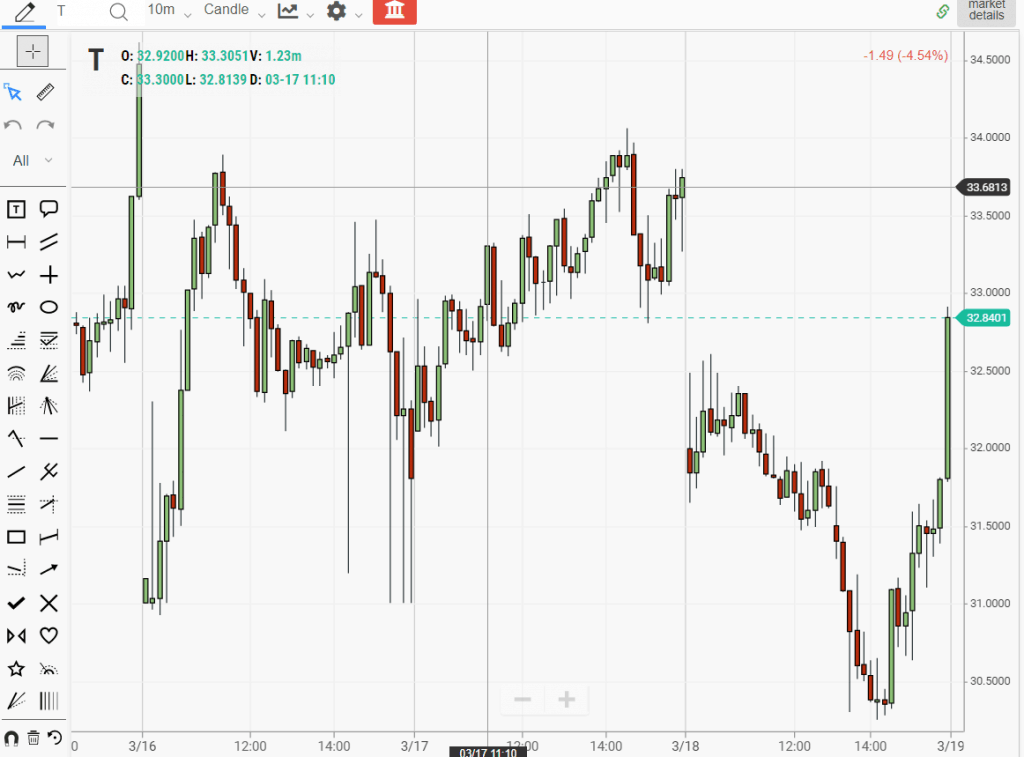
Since that stock split, AT&T stock rose and still had a positive Q2 2020 earnings report. CEO John Stankey spoke about the results.
“Our core subscription businesses proved to be resilient in the face of the economic downturn. Our mobility and business wire line segments performed well, and we grew EBITDA[ earnings before interest, taxation, depreciation, and amortization] margins in both areas. EBITDA of $7.8 billion was up year-over-year with both EBITDA margins and service margins expanding, and that’s inclusive of COVID impacts,” said Stankey.
He added that AT&T’s cash flow grew despite the pandemic.
“Cash flow was impressive even during the pandemic. Cash from operations came in at more than $12 billion and free cash flow came in at $7.6 billion,” said Stankey.
Stankey also noted that the quarantine helped AT&T’s cable and HBO Max streaming service grow as well.
“Our software-based entertainment businesses performed well. ATT TV subscriber growth in its first full quarter was better than we expected and it’s our highest performing video product with customer satisfaction, double the level of our legacy TV services,” added Stankey.
AT&T stock and business division rebounded and increased after its reverse stock split almost 20 years ago.
Citigroup
Citigroup (NYSE:C) had a 10-for-1 reverse stock split in 2013. During the split, some shareholders disapproved of the split. One shareholder commented on the split at the time.
“You guys know what the price of the stock is. It is the same price when we did the reverse split. This stock has to reach $600 for me to break even. Bring it down to $4.65 and then maybe it can climb back up to $60,” said the shareholder.
CEO Michael Corbat spoke about the stockholders’ concerns.
“This reverse stock split wasn’t done to engineer the stock price. It was done to reduce volatility and to get shareholders out of the stock who were using it as a trading vehicle, ” said Corbat.
Citigroup has better-than-expected earnings after reverse stock split
Despite the coronavirus crisis, Citigroup exceeded Wall Street expectations. Corbat spoke about the Q2 2020 results.
“While credit costs weighed down our net income, our overall business performance was strong during the quarter, and we have been able to navigate the COVID-19 pandemic reasonably well. The Institutional Clients Group had an exceptional quarter, marked by an increase in Fixed Income of 68%. Global Consumer Banking revenues were down as spending slowed significantly due to the pandemic,” said Corbat.
“We entered this crisis from a position of strength. During the quarter, our regulatory capital increased and our CET1 [common equity tier one capital] ratio improved to 11.5%, comfortably above our new regulatory minimum of 10%. We continued to add to our substantial levels of liquidity and our balance sheet has plenty of capacity to serve our clients,” added Corbat.
Corbat also spoke about how Citigroup was prepared for more volatility in the future.
“With a sharp emphasis on risk management, we are prepared for a variety of scenarios and will continue to operate our institution prudently given this unprecedented situation,” said Corbat.
Citigroup stock flourished after its reverse stock split and help from the Federal Reserve.
Aurora Cannabis latest company to have reverse stock split
In a more current example of a stock split, Aurora Cannabis (NYSE:ACB) is implementing a 1-for-12 reverse stock split. The corporation will reduce its available shares to investors from 1.3 billion to roughly 110 million.
Despite the boom in pot sales during the worldwide quarantine, the marijuana company’s shares have plummeted. Aurora explained its decision in a statement.

“The company intends to use a portion of this available capacity to provide further balance sheet strength and preserve flexibility given macroeconomic uncertainty caused by COVID-19,” said Aurora in a statement.
What do financial experts say about Aurora Cannabis’ reverse stock split?
In response to the announcement, Innovation Shares managing director Matt Markiewicz said that Aurora had no choice but to implement the reverse stock split. Aurora stock plunged to 69 cents a share. With that disappointing share price, the stock’s in danger of being delisted from the New York Stock Exchange (NYSE).
“They had to do this to stay compliant with NYSE rules. They can’t jeopardize the U.S. because of the large shareholder base here. There’s no way the company would risk cutting that conduit,” said Markiewicz.
Jefferies analyst Owen Bennett believes that the reverse stock split will hurt investors’ confidence in the cannabis company’s stock.
“Today’s announcement of a further [at-the-market program], alongside language that suggests [how] this will be used, will be a blow to sentiment,” wrote Bennett in a note to clients.
In contrast, Cowen analyst Vivien Azer notes that Aurora Cannabis’ positive cash flow can help its reverse stock split. However, she said that she had concerns about its overall balance sheet.
She noted that the cash flow is “a positive (particularly in the current environment), but we[Cowen] continue to have concerns on the balance sheet.”
Aurora has positive Q3 2020 earnings
Despite the concerns about Aurora’s reverse stock split, the company had a positive and negative Q3 2020 earnings report. While Aurora still hasn’t turned a profit, the company had an 18% increase in revenue to $78.4 million. CEO Michael Singer spoke about the corporation’s results.
“I am incredibly proud of the Aurora team for working through these challenging times in order to maintain uninterrupted operations at all of our production facilities and ensure we continue to meet the needs of our patients and consumers,” said Singer.
“I am also pleased that our third quarter 2020 financial results were in-line with our expectations, and that we remain firmly on track with the cost-savings and capex[capital expenditure] goals we detailed during our business transformation plan in February 2020,” added Singer.
“As outlined in our press release on Friday, revenue for Q1 2020 was $58.7 million with gross profit at $10.6 million. Both of these metrics are in line with the numbers previously estimated on the year-end call,” concluded Singer.
When Aurora Cannabis has a reverse stock split, it remains to be seen how it will impact investors.
Staffing 360 solutions has reverse stock split
Staffing 360 Solutions is another corporation that had a reverse stock split. The corporation’s stock will be sold in a 1-for-5 split. CEO Brendan Flood spoke about the shareholders’ decision in 2018.
“At a Special Meeting of Stockholders today, the stockholders of Staffing 360 Solutions voted by a large margin (over 74% of outstanding shares) to provide the Board with the authority to effect a reverse stock split at a ratio in the range of 1-for-2 to 1-for-10, such ratio to be determined by the Company’s Board of Directors. After careful consideration, the Board determined the appropriate reverse stock split to be a ratio of 1-for-5,” said Flood.
Staffing 360 Solutions Q1 2020 results mixed
After its reverse stock split, Staffing 360 Solutions had a mixed Q1 2020 revenue report.
While the corporation’s revenue was down, it was still in line with Wall Street expectations. Flood spoke about the Q1 2020 results.
As outlined in our press release on Friday, revenue for Q1 2020 was $58.7 million with gross profit at $10.6 million. Both of these metrics are in line with the numbers previously estimated on the year-end call.
Principal accounting officer Sharnika Viswakula spoke about the results as well.
“For the first quarter of 2020, revenue of $58.7 million reflects a decrease of 20.5% over the prior year of $73.8 million,” said Viswakula.
Staffing 360 Solutions has had mixed results since its reverse stock split.
Reverse stock splits affect investors in may different ways
In reverse stock splits, many corporations have been impacted in many ways. For investors, there are different results that can affect their ability to buy shares of a company’s stock and profit after the stock splits.
If investors want more information about reverse stock splits and how they affect their portfolios, they can practice trading on TradingSim. With research and simulated trades, investors can find the best stocks that can persevere after reverse stock splits.
The post What does a reverse stock split mean for investors? appeared first on - Tradingsim.
-
 Business3 weeks ago
Business3 weeks agoBernice King, Ava DuVernay reflect on the legacy of John Lewis
-
World News3 weeks ago
Heavy rain threatens flood-weary Japan, Korean Peninsula
-
 Technology2 weeks ago
Technology2 weeks agoEverything New On Netflix This Weekend: July 25, 2020
-
Finance3 months ago
Will Equal Weighted Index Funds Outperform Their Benchmark Indexes?
-
Marketing Strategies7 months ago
Top 20 Workers’ Compensation Law Blogs & Websites To Follow in 2020
-
 World News7 months ago
World News7 months agoThe West Blames the Wuhan Coronavirus on China’s Love of Eating Wild Animals. The Truth Is More Complex
-
Economy9 months ago
Newsletter: Jobs, Consumers and Wages
-
 Finance8 months ago
Finance8 months ago$95 Grocery Budget + Weekly Menu Plan for 8




